Stretch Your Hamstrings, Save Your Back
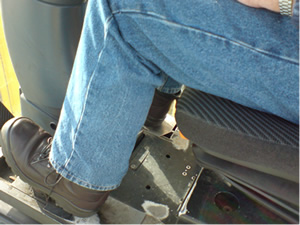 The Hamstrings at the back of the leg can become tight from too much sitting and that is because as you work, they are working overtime, this can leave them tight and short and cause you back pain. Are your hamstrings working double duty?
The Hamstrings at the back of the leg can become tight from too much sitting and that is because as you work, they are working overtime, this can leave them tight and short and cause you back pain. Are your hamstrings working double duty?
Why use a Hamster®
For more than two decades we have demonstrated sitting with a pair of tennis balls under your hamstrings can assist the Hamstrings in staying the correct length that's because the hamstrings need to stretch up and over the balls as you sit.
However, when operating heavy machinery or driving, having tennis balls loose to roll around in the cabin and get under pedals is dangerous. Hamster® solves that.
Made from rugged soft nylon (the kind used in back packs and outdoor luggage) Hamster® has been designed to survive in the most challenging work environments so you and your lower back can have a great day, all day long.
We've promoted and used this method successfully for over two decades with our TBT© Tennis Ball Technique. Because our Wellness at Work clinics are "No change No charge" all our treatments and patient recommendations have to do one thing.
They all have to, work.
And Hamster® works. It works because it does something that's hard to do in normal therapy, it takes pressure off the Psoas muscles.
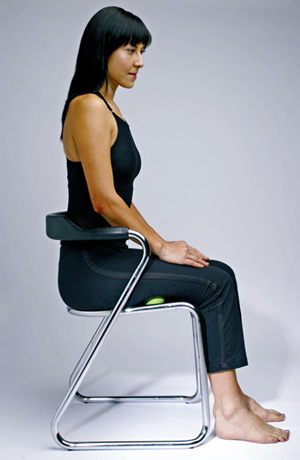 The Psoas are probably the single most important postural and structural muscles in the body and most people have never heard of them.
The Psoas are probably the single most important postural and structural muscles in the body and most people have never heard of them.
There is a long list of reasons why they are so important. Biomechanical literature suggests that the psoas major may aid in the stabilization of the lumbar spine and has the potential to generate compressive forces that can increase spinal stiffness.
The many functions of psoas major are an area of controversy in medical literature because, there's such a large number of tasks that Psoas are involved in.
With our trauma therapy work we understand during prolonged periods of stress, your Psoas can become severely contracted and sadly this same level of contraction can occur simply when you sit for long periods.
Excessive running or walking, especially if you run when you're tired, sleeping in the foetal position, doing lots of sit-ups can stress Psoas as well.
Psoas is so important because it connects the upper half of the body, to the lower half of the body. Structurally, your psoas are the deepest muscles of your core. They attach from your 12th thoracic vertebrae right down to your 5th lumbar vertebrae, then pass forward through your pelvis and attach to the inside of your femurs so the Psoas connect your spinal vertebrae to your legs.
Psoas muscles allow you to bend your hips and lift your legs up towards your chest. They also help to move your leg forward when you walk or run. These same muscles flex your trunk forward when you bend over to pick up something from the floor and most importantly, they stabilize your spine when you're sitting, that's the whole time you are sitting! This means they work hard and sometimes, that's all day!
Psoas are vital not only to your structural well-being, but also to your psychological well-being. This is because of their connection to your adrenals and the role they play in beginning the bodies fight and flight response. This is because they are the primary muscles that fire when you are startled or under stress. When you are shocked, they fire first as Psoas contracts to compresses the adrenals glans and this helps to get you stimulated into action.
However, unless you want to suffer from adrenal fatigue and a wide range of hormonal imbalances you don't want to have a perpetually tight Psoas. And during prolonged periods of stress, your psoas can be constantly tight.
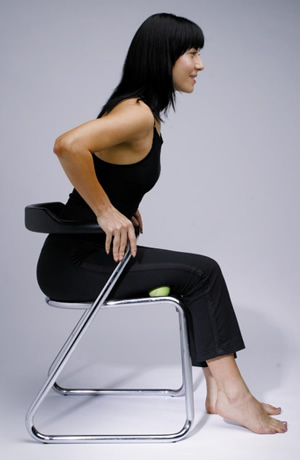 A similar contraction occurs when you sit for long periods of time and it can elevate your adrenaline and cortisol levels. Cortisol is a fat storing hormone, so you don't want that!
A similar contraction occurs when you sit for long periods of time and it can elevate your adrenaline and cortisol levels. Cortisol is a fat storing hormone, so you don't want that!
But that doesn't mean you should automatically stretch your psoas. In fact, depending on your situation, stretching your psoas may actually do more harm than good! So, the key is to avoid getting your psoas tight in the first place by keeping your hamstrings lengthened.
The psoas major muscle is not only considered as a pain source in athletes, it affects office workers machine operators courier and Uber drivers. Literally anyone who spends a lot of their day sitting.
Sometimes it's just not possible to follow best practice and get up to move around every 20 minutes.
That's where Hamster® comes in. It works for you all day, so you don't have to spend all night with lower back pain.
Ideally stretching your muscles and releasing the tension on the psoas is the best way to prevent this from happening but it takes time and daily attention to keep your psoas muscles relaxed, stretched, and strong. One of the ways we can release the hip flexors is to activate or strengthen the hamstrings. Our body is programmed to relax the muscles on one side of the body, when the muscles on the other side are engaged. So, with your new Hamster® keeping your hamstrings longer, the pressure comes off good old psoas and you can avoid having a psoas muscle imbalance.
What things can psoas imbalance cause?
Leg Length Discrepancy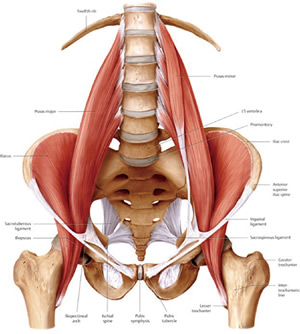
A tight psoas muscle can cause your pelvis to rotate forward. This in turn can cause an internal rotation of your leg on the affected side. The opposite leg will rotate externally in an effort to counter-balance and this will make the affected leg longer. Every time you take a step, it drives that leg deeper up into your hip socket and this can lead to functional leg length discrepancy.
Knee and Low Back Pain
If you experience knee or low back pain with no apparent cause, it may be coming from your psoas muscles placing a twist pressure on the femur and this can cause your knee and low back to torque as they are no longer tracking normally. You are asking your knees to act as universal joints instead of hinges as they were designed.
Postural Problems
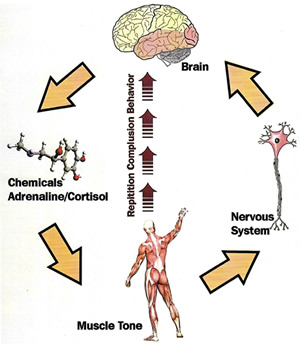 When your psoas is too short or tight, it can pull your pelvis into an anterior tilt, compressing the spine and pulling your back into hyperlordosis making your butt stick out. Or if your psoas is overstretched over tired and weak, it can flatten the natural curve of your lumbar spine giving you no butt at all.
When your psoas is too short or tight, it can pull your pelvis into an anterior tilt, compressing the spine and pulling your back into hyperlordosis making your butt stick out. Or if your psoas is overstretched over tired and weak, it can flatten the natural curve of your lumbar spine giving you no butt at all.
These misalignments are often caused by tight hamstrings pulling on and causing the sacrum to lose its natural curve which results in a flattened lumbar spine. All this can lead to lower back injuries and bulging intervertebral discs, potentially leaving you in a world of pain.
A tight Psoas increases both Adrenaline and Cortisol increasing muscle tone so you ache more than the average person, this can also cause rapid weight gain and make it hard to think!
If you must sit for work or other reasons, sit with good posture and be sure your hips are level or slightly higher than your knees. Avoid bucket seats and chairs without support for your low back. Try to get up and move around every hour.
Add support to your car seat.
Or:
Use a Hamster® underneath your Hamstrings and even behind your lower / lumbar spine to keep the psoas and hip sockets released. Remember to stop every 2 hours to stretch and take a short walk.
Where can I buy a Hamster?
For more details and buying online, check out the Hamster on AzollaHealth.com
Cheers.

Chris Toal
Managing Director Wellness at Work Ltd.

Blog Post by Chris Toal
Added 14-June-2021
More Blog Posts
- Stretch Your Hamstrings, Save Your
- Cold water, healing or harm?
- Personal Training
- Alla Kalinina's one off hand embroidered designs
- Presentation & training at Massage NZ
- Facing up to your emotions!
- Who is going to pay your bills?
- Understanding your intuition
- Understanding our treatment methods
- Stop cooking yourself!
- Bacteria whispering
- Pet massage for our furry friends
- Tinnitus; the bells are ringing!
- The real cost of OOS
- Doing your own 'Haka' for health!
It all starts with 90 minutes that could change your life!
With our exclusive BodyAudit© we both find out what is really wrong with you, so finally you can get started on your journey back to health.
Our Team

Chris Toal
A passionate Forensic Bodyworker for two decades, Chris says that he's only a facilitator of communication between you and your body. He believes that many persistent unresolved injuries and conditions are only waiting for...
more
Alla Kalinina
Alla has a deep base to draw on. A renowned dance choreographer and fitness instructor in her homeland, Ukraine, her Aerobic dance teams were European champions. Alla is also a qualified mobility therapist...
moreLike a free info pack?
We would really love to help. No change No charge!
Provide us with a quick outline of your health issues and we will send you relevant info and references from others that have been where you are and are now well. Stop struggling; this is not living - you are supposed to be clear headed and happy.